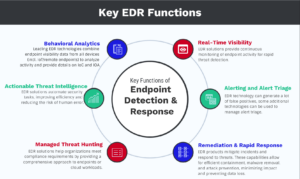EDR Stands For tools that detect and analyze threats to endpoints such as employee workstations and laptops, servers, mobile devices, BYOD systems or IoT equipment. Telemetry from each device is collected using software agents on each device before being analyzed to detect attacks that escape basic prevention methods such as antivirus protection.
Security teams also provide response capabilities such as isolating suspected endpoints (known as network containment ) from the rest of the network in order to rapidly track and respond to breaches that arise within networks.
Real-time visibility
EDR services provide real-time visibility into the behavior of an endpoint device, allowing you to monitor for potential threats and take measures against them. This enables your team to detect, investigate, and respond swiftly to attacks before they cause serious harm.
For optimal security, it is key to choose an EDR Stands For service with various advantages:
Real-time visibility into attacker activities: EDR solutions provide real-time visibility into attacker activities by collecting endpoint telemetry data and sending it back to a central console for analysis by machine learning and predictive analytics systems. Once identified, these machines use machine learning techniques and predictive analysis models to spot suspicious activity before any breach occurs – meaning you can detect and prevent many attacks which were otherwise undetected by traditional antivirus (AV) or next-generation AV (NGAV).
EDR solutions that deliver broad visibility across an enterprise should utilize multiple detection methods to detect advanced threats. Furthermore, these EDR systems should perform deep analyses on files, registry settings and system information and alert when something unusual has been identified. If possible look for EDR products independently tested by MITRE ATT&CK Evaluation as they offer advanced detection capabilities.
Automated threat response
Detecting threats is key to protecting against advanced attacks. Once an adversary breached your perimeter defenses, it’s crucial that it’s identified quickly and stopped before any more damage can occur. EDR solutions help detect adversary activity by collecting endpoint data and correlating it with contextualized intelligence delivered in real time; additionally they can remotely control an endpoint to contain and mitigate an attack without impacting other parts of the network.
An EDR solution collects endpoint telemetry data through software agents and transmits it to a central repository, then applies machine learning algorithms to detect anomalies or suspicious behavior and generate alerts for security analysts. An EDR may also include functions like sandboxing – placing files with malware into safe environments designed to replicate the conditions of specific segments of a network – for additional protection against threats.
A great EDR solution should analyze data across various sources – cloud, IoT and endpoints – in order to provide security teams with visibility and context across them all. This eliminates the complexity associated with investigating incidents caused by siloed tools and data; additionally it speeds up investigation of incidents by decreasing investigation times while remediating threats quicker, leading to faster detection and response. It must also integrate with cyber threat intelligence so analysts can quickly comprehend adversarial tactics, techniques and procedures (TTPs) more quickly in order to respond more effectively against adversarial TTPs more quickly.
Behavioral detection
Behavioral detection as an EDR service goes beyond mere visibility to monitor attackers as they attempt to penetrate your business, and provides you with tools to take actions against any threats not detected by other tools, from sandboxing and quarantining, that may prevent further attacks on your network.
Managed EDR services leverage advanced machine learning technology to correlate and analyze endpoint telemetry, shortening response times for security operations analysts while expediting investigations and remediations efforts faster. They can even detect zero-day threats that evade traditional security controls such as firewalls and intrusion prevention systems.
EDR solutions can monitor and record events from laptops, desktop PCs, mobile devices, servers, and IoT devices to detect suspicious activity that should be sent back into a central repository for further examination. EDR solutions also use contextual information from associated events to generate alerts for security analysts to respond accordingly.
They can perform remote forensics analysis on infected systems to understand how a threat gained entry to your network and what damage was done once inside, and can trigger automated responses such as changing an endpoint’s password or isolating it from other nodes in order to minimize damage. All alert data analyzed by experts is then stored to provide forensic capabilities allowing them to track threats more closely as well as learn from past attacks.
Isolation
An EDR solution is an invaluable asset in protecting against and responding to cyber threats. It works by monitoring endpoint data to detect suspicious activity and possible attacks; identify threats prioritization for analysts; provide actionable intelligence, shorten response times; store data to allow forensics investigations.
EDR solutions continuously monitor every file that interacts with an endpoint to determine its safety. If it begins acting differently than expected, EDR will detect this threat and alert security personnel immediately. It then attempts to understand why the file changed behavior in order to pinpoint and combat possible attacks against it.
EDR solutions use sandboxing to detect malicious files, providing a safer testing and monitoring environment than would put the security of their network at risk. Sandboxing allows the EDR solution to identify characteristics and attributes associated with each file so it can adapt its defenses against future threats.
EDR solutions can prevent threats from spreading across an entire network, which is particularly essential against sophisticated threats like ransomware that aim to infect as many processes, applications, and users as possible. They also allow Yale data protection staff to isolate a compromised host in order to keep our mission-critical systems operational.
